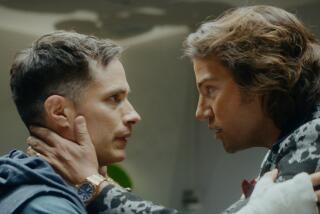TV review: ‘Taking on Tyson’
- Share via
Oh, the paths a life may take. Mike Tyson, the former heavyweight champion, is now the star of “Taking on Tyson,” a new Animal Planet series premiering Sunday that plays off his lifelong love of pigeons. He has raised them since he was a kid, in humble coops and grand; now, for the purposes of this series at least, he wants to race them. (The first punch he ever threw, he says here, and has said before, was at someone who stole and killed one of his birds — “It seemed like the right thing to do.”) It’s a great subject with a great setting — the rooftops of urban New Jersey and New York — but it is repeatedly entangled in and dragged to earth by the hectic conventions of reality television.
The whipsaw edits — most of the shots last only a second or two — are meant, clearly, to create excitement and movement, but in doing so mask actual movement and fragment space. Even as the direction seems to be generous with information — so many pictures! — it beats you back. It is all busy, often arty surface, with no time allowed to stop and look and breathe the air, an especially unproductive approach in a story explicitly presented as a search for peace, for calm, for balance. You are hurried along — hurried in circles, really — and allowed no more than a blurred and fleeting glimpse of places and people who beg for a longer look.
Tyson’s effect is oddly childlike, partly because of the way he speaks, partly because of what he says, and partly because the series paints everything between his childhood and what might be termed his post-career recovery — all that boxing stuff, the drugs, the prison time — as just a long detour on his way back to the birds and some lost, truer self. He is “looking for somewhere to belong,” we are told — we are told things constantly, as if the producers do not trust you to work these out for yourself.
Although he’s the boss, he does indeed seem like just one of the boys in “Taking on Tyson,” as he and his team recite together the “five P’s”: “Proper preparation prevents poor performance.” There is Mario Costa, an old friend who owns the Jersey City property where Tyson’s birds roost. Young brothers Junie and Ricky Roman take care of the coops and also see the birds as the key to staying straight. Vinnie Torre, president of the Lyndhurst Homing Pigeon Club, is the wise old Obi-Wan who comes to school them all, men and birds.
For all its faults, there remains something deeply appealing here. The story of the brute softened by a love of animals does not pale with repetition. (Marlon Brando’s washed-up boxer Terry Malloy kept pigeons in “On the Waterfront,” set not far from Tyson’s own coop.) It may have been that Tyson’s interest in racing pigeons, which for the first episode at least remain undifferentiated bit players in his personal redemption tale, predated the pitching of this TV show, but its “Rocky” scenario of ragtag amateurs taking on the establishment feels buckled on to create conventional dramatic interest. Yet for years and years, Tyson kept birds merely because he loved them — and that is human interest.
Much-abused city dwellers of noble proportions and famous heart (“They’re very faithful,” Brando tells Eva Marie Saint, “they get married just like people”), they represent both the possibility of flight and the attachment to place, freedom and devotion. “They give you their all,” says Torre. “They get home to you; it’s the greatest thing in the world, I think.”
More to Read
The complete guide to home viewing
Get Screen Gab for everything about the TV shows and streaming movies everyone’s talking about.
You may occasionally receive promotional content from the Los Angeles Times.







